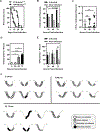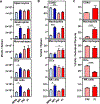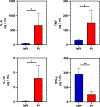Roles of natural resistance-associated macrophage protein-1 in modulating bacterial distribution and immune responses during Salmonella enterica serovar Typhimurium infection in murine pregnancy
- PMID: 35851978
- PMCID: PMC9509426
- DOI: 10.1111/aji.13599
Roles of natural resistance-associated macrophage protein-1 in modulating bacterial distribution and immune responses during Salmonella enterica serovar Typhimurium infection in murine pregnancy
Abstract
Problem: Salmonella enterica serovar Typhimurium (S.Tm) infection in Nramp1+/+ mice during pregnancy can lead to profound bacterial growth in the feto-placental unit and adverse pregnancy outcomes, including fetal loss, maternal illness and death. The kinetics and mechanisms by which S.Tm gains entry within individual feto-placental unit, and disseminates through tissues leading to placental resorption and fetal demise remain unclear.
Method of study: Mice were systemically infected with S.Tm. Bacterial burden within spleen and individual placentas, and placental/fetal resorptions were quantified. Flow cytometric analysis of immune cell types in the spleen and individual placentas was performed. Cytokine expression in maternal serum was determined through cytometric bead array.
Results: Systemic infection with S.Tm resulted in preferential bacterial proliferation in placentas compared to the spleen in Nramp1+/+ mice. At 24 h post-infection, the mean infection rate of individual placentas per mouse was ∼50%, increasing to >75% by 72 h post-infection, suggesting that initial infection in few sites progresses to rapid spread of infection through the uterine milieu. This correlated with a steady increase in placental/fetal resorption rates. Placental infection was associated with local increased neutrophil percentages, whereas numbers and percentages in the spleen remained unchanged, suggesting dichotomous modulation of inflammation between the systemic compartment and the feto-maternal interface. Reduced survival rates of pregnant mice during infection correlated with decreased serum IFN-γ but increased IL-10 levels relative to non-pregnant controls.
Conclusion: Pregnancy compromises host resistance conferred by Nramp1 against S.Tm through compartment-specific regulation of maternal and placental cellular responses, and modulation of systemic cytokine expression.
Keywords: Nramp1; Salmonella; cytokines; inflammation; placenta; pregnancy.
© 2022 National Research Council Canada and John Wiley & Sons Ltd. Reproduced with the permission of the Minister of Innovation, Science and Economic Development.
Figures



Similar articles
-
IFN-alpha receptor deficiency enhances host resistance to oral Salmonella enterica serovar Typhimurium infection during murine pregnancy.Am J Reprod Immunol. 2021 Oct;86(4):e13454. doi: 10.1111/aji.13454. Epub 2021 May 29. Am J Reprod Immunol. 2021. PMID: 33991140
-
Type I interferons differentially modulate maternal host immunity to infection by Listeria monocytogenes and Salmonella enterica serovar Typhimurium during pregnancy.Am J Reprod Immunol. 2019 Jan;81(1):e13068. doi: 10.1111/aji.13068. Epub 2018 Dec 4. Am J Reprod Immunol. 2019. PMID: 30376200 Free PMC article.
-
Modulation of Th17 and regulatory T-cell responses during murine pregnancy contributes to increased maternal susceptibility to Salmonella Typhimurium infection.Am J Reprod Immunol. 2017 Dec;78(6). doi: 10.1111/aji.12742. Epub 2017 Oct 9. Am J Reprod Immunol. 2017. PMID: 28990696
-
Salmonella enterica serovar Typhimurium-induced placental inflammation and not bacterial burden correlates with pathology and fatal maternal disease.Infect Immun. 2010 May;78(5):2292-301. doi: 10.1128/IAI.01186-09. Epub 2010 Mar 1. Infect Immun. 2010. PMID: 20194592 Free PMC article.
-
The influence of the oral microbiota in full-term pregnant women on immune regulation during pregnancy.J Reprod Immunol. 2024 Sep;165:104298. doi: 10.1016/j.jri.2024.104298. Epub 2024 Jul 7. J Reprod Immunol. 2024. PMID: 39002425 Review.
Cited by
-
The immunogenetics of tuberculosis (TB) susceptibility.Immunogenetics. 2023 Jun;75(3):215-230. doi: 10.1007/s00251-022-01290-5. Epub 2022 Dec 13. Immunogenetics. 2023. PMID: 36512056 Review.
References
-
- Kalagiri RR, Carder T, Choudhury S, Vora N, Ballard AR, Govande V, et al. Inflammation in Complicated Pregnancy and Its Outcome. Am J Perinatol 2016. Dec;33(14):1337–56. - PubMed
Publication types
MeSH terms
Substances
Grants and funding
LinkOut - more resources
Full Text Sources
Medical
Research Materials

